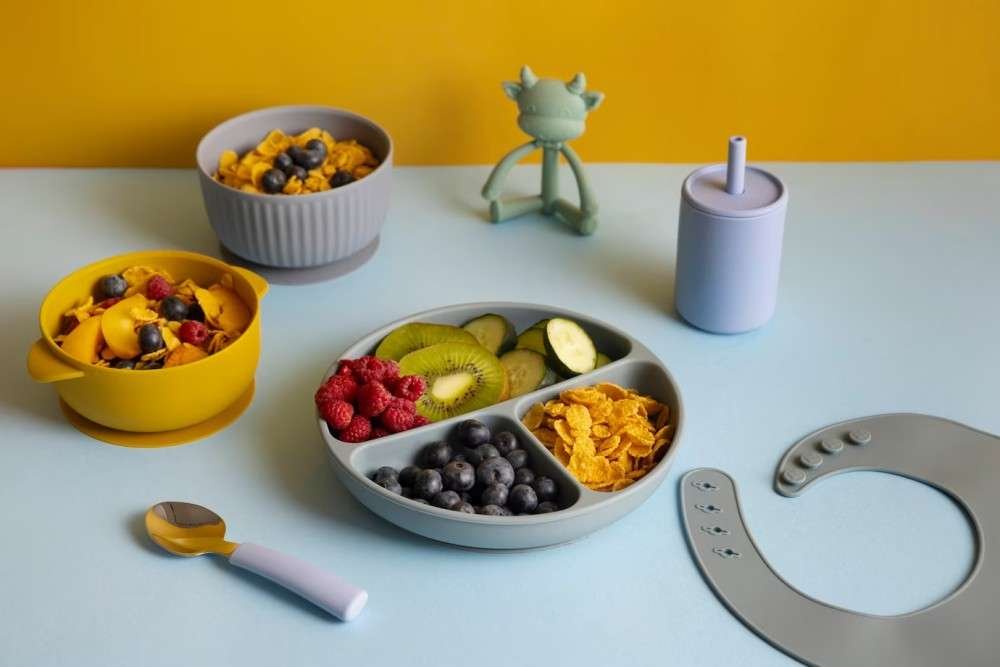GET 10% OFF ON FIRST ORDER USE CODE: WELCOME10 | Min. Cart Value Rs 499
GET 10% OFF ON FIRST ORDER USE CODE: WELCOME10 | Min. Cart Value Rs 499
What and How Much, Should I Feed My Baby?

Introduction
Welcoming a new member into your family is a joyous occasion. As a parent, one of your primary concerns is ensuring your baby receives proper nutrition for healthy growth and development. Understanding what and how much to feed your baby can be both exciting and overwhelming. In this comprehensive guide, we will explore age-appropriate feeding recommendations, the importance of various nutrients, and provide practical tips to make your feeding journey a smooth and enjoyable one.
The Early Months (0-6 Months)
During the first six months of your baby’s life, their primary source of nutrition will be breast milk or formula. This section will delve into the benefits of breastfeeding, formula feeding, and the recommended frequency and quantity of feeds. We will also discuss the introduction of solid foods, highlighting when and how to begin this exciting milestone

Introducing Solid Foods (6-12 Months)
As your baby approaches the six-month mark, it’s time to introduce them to solid foods. This section will cover the basics of starting solids, including when to begin, signs of readiness, and the appropriate consistency of foods. We will guide you through the gradual introduction of a variety of food groups, ensuring a balanced diet. Safety considerations, such as avoiding potential allergens, will also be addressed.

Nutritional Needs and Food Choices (12-24 Months)
During the second year of life, your baby’s nutritional needs evolve significantly. This section will outline the essential nutrients required for healthy development, including carbohydrates, proteins, fats, vitamins, and minerals. We will explore various food choices within each category, providing you with a comprehensive list of suitable options. Additionally, we will address common concerns, such as vegetarian or vegan diets, and offer guidance on meeting your child’s nutritional requirements.
Establishing Healthy Eating Habits
In this section, we will discuss the importance of structured mealtimes and establishing a positive feeding environment. We will explore portion sizes, appropriate snacks, and strategies to handle picky eating. Furthermore, we will touch on the role of self-feeding and the transition from purees to finger foods.

Benefits of healthy eating habits
Establishing healthy eating habits for kids is an invaluable investment in their long-term well-being. By being a positive role model, introducing a variety of foods, setting consistent meal times, making healthy foods enjoyable, and teaching moderation, parents can lay the foundation for a lifetime of healthy choices. Remember, patience and persistence are key, as it takes time for children to develop and embrace healthy eating habits. By creating a supportive and positive environment, you can set your child on a path towards a healthy and balanced relationship with food.
Healthy eating time table
Creating a healthy eating timetable for kids can help ensure they receive balanced nutrition throughout the day. While individual needs may vary, the following timetable provides a general guide:
- Breakfast (7:00-8:00 AM):
- Include a source of protein (e.g., sprouts, Greek yogurt, nut butter) for sustained energy.
- Serve whole grains (e.g., whole grain cereal, oatmeal, whole wheat toast) for fiber.
- Offer fruits or vegetables for essential vitamins and minerals.
- Provide a calcium source (e.g., milk, fortified plant-based milk) for bone health.
- Mid-Morning Snack (10:00-10:30 AM):
- Choose a nutritious snack option, such as fresh fruits, sliced vegetables with dip, or a small handful of nuts or seeds.
- Pair with a beverage like water or milk.
- Lunch (12:00-1:00 PM):
- Include a lean protein source (e.g., chicken, fish, tofu) for muscle development.
- Serve whole grains (e.g., brown rice, whole wheat pasta, quinoa) for energy and fiber.
- Offer a variety of vegetables and fruits for vitamins and minerals.
- Provide a calcium source (e.g., cheese, yogurt) for bone health.
- Afternoon Snack (3:00-3:30 PM):
- Opt for a balanced snack, such as a yogurt cup, whole grain crackers with cheese, or a homemade smoothie with fruits and yogurt.
- Include a source of protein and fiber for satiety.
- Dinner (6:00-7:00 PM):
- Ensure a balanced meal with a protein source (e.g., lean meat, legumes, tempeh).
- Serve whole grains or starchy vegetables (e.g., brown rice, sweet potatoes, whole wheat bread) for sustained energy.
- Include a variety of vegetables for vitamins, minerals, and fiber.
- Offer a calcium source (e.g., milk, cheese) for bone health.
- Evening Snack (8:00-8:30 PM):
- Choose a light, nutritious option, such as sliced fruits, a small portion of whole grain cereal with milk, or a handful of trail mix.
- Avoid heavy or sugary snacks close to bedtime.
Important Considerations:
- Encourage drinking water throughout the day to stay hydrated.
- Adapt portion sizes based on your child’s age, appetite, and activity level.
- Involve your child in meal planning and preparation to increase their engagement and food acceptance.
- Still if your kid not eating properly then you should personally meet with a pediatrician or any professional.
Remember, this timetable serves as a general guideline, and you can adjust it to fit your child’s routine and preferences. Regular mealtimes, balanced nutrition, and a positive eating environment are key components in fostering healthy eating habits for kids.

Involve child into food making process
Involving your child in the food-making process is a wonderful way to cultivate their interest in healthy eating and empower them to make nutritious choices. Here are some ways you can engage your child in the kitchen:
- Meal Planning: Include your child when deciding what meals to prepare for the week. Discuss different food options, ask for their input, and encourage them to choose ingredients they enjoy.
- Grocery Shopping: Take your child along when you go grocery shopping. Let them help you find items on the list, explore different fruits and vegetables, and learn about healthy food choices. Encourage them to pick a new fruit or vegetable to try.
- Food Preparation: Assign age-appropriate tasks to your child while preparing meals. Younger children can wash vegetables, tear lettuce, or mix ingredients, while older children can chop soft vegetables with a kid-safe knife or help measure ingredients.
- Recipe Selection: Allow your child to select recipes from kid-friendly cookbooks or online resources. Guide them towards nutritious options that include a variety of food groups. Together, read the recipes, discuss the ingredients, and follow the steps together.
- Cooking Together: Set aside dedicated cooking time with your child. Explain the cooking techniques, demonstrate safe practices, and let them assist you in preparing the meal. Encourage them to ask questions and engage in conversation about the ingredients and the importance of balanced nutrition.
- Taste Testing: Involve your child in taste testing different ingredients or seasonings. Encourage them to describe flavors, textures, and preferences. This helps expand their palate and develop an appreciation for a variety of foods.
- Meal Presentation: Allow your child to be creative in plating the dishes. Let them arrange fruits and vegetables in fun shapes or create smiley faces using nutritious ingredients. This can make eating more enjoyable and appealing for them.
- Sharing Meals: Encourage your child to share the meals they helped prepare with family members or friends. This promotes a sense of pride and accomplishment, and it also allows them to see others enjoying the food they contributed to.
Remember, safety is paramount in the kitchen. Supervise your child closely, teach them proper handling of kitchen tools, and ensure they understand safety guidelines.
By involving your child in the food-making process, you’re not only teaching them valuable skills but also fostering a positive relationship with healthy eating. It’s an opportunity to bond, learn, and create lifelong memories together in the kitchen.
Free shipping
Free Returns
Secured Payments

SpartanKids are like one big family with a goal in mind to help make a smarter generation and optimize the experiences of students, teachers and families.
Our Products
Get Newsletter

Copyright 2022 © Spartan Kids. All rights reserved.
Design & Developed By : Spartan Branding | Disclaimer





